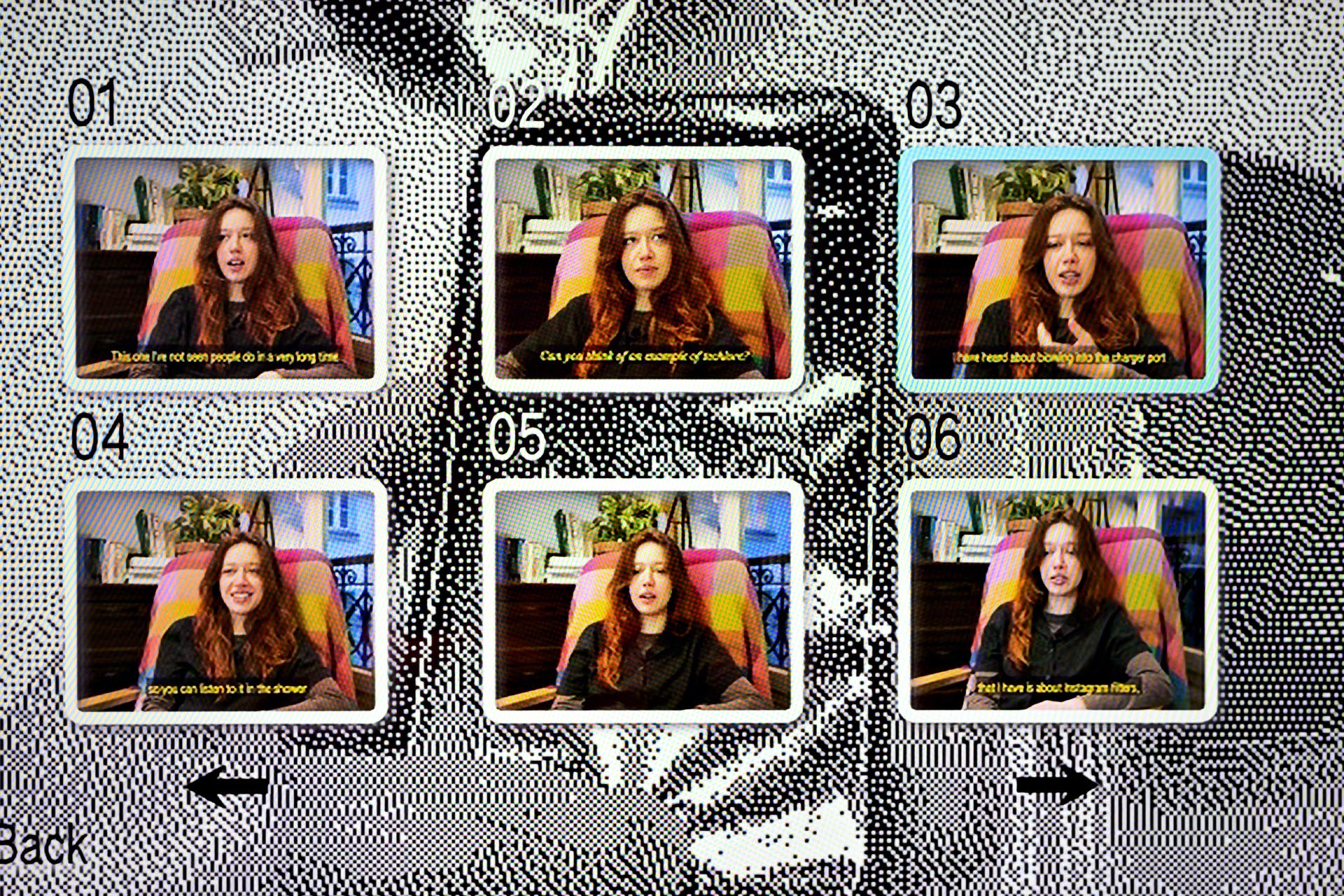
Jeroen van Loon, ‘Reinforced Learning'(2023), on view at ‘Don’t Be Evil’. Photo: Pieter Kers
‘Lets turn big tech into fair tech’ – visiting IMPAKT festival
Standing up for our digital rights is long-overdue. That’s why IMPAKT organized Our Terms, Our Conditions: a five-day festival that challenges the big-tech corporations that have too long defined our terms of engagement with them. Matthew Sturt-Scobie visits the festival to see how IMPAKT decodes this (to many) inaccessible area of debate. Will people leave the festival energised and informed on how to respond to the issues brought to the fore?
First stop: Reclaiming Digital Agency by CODE @ Het Huis Utrecht (from November 8 onwards @ IMPAKT)
On the first floor of Het Huis, a warm and lusciously antique space of wooden banisters, high ceilings and tall, bright windows, I find the exhibition Reclaiming Digital Agency. The exhibition features works made this year by CODE, who define themselves as ‘an annual, six-month co-creation project that brings together artists and non-artists from Belgium, Germany, the Netherlands and other countries’.
Within this space, there are a couple of works that (literally) work, in that they ask the viewer to exchange their input for feedback – the audience isn’t just a witness. My personal favourite is Clickedy Click (Tracking for Love) by the clickedy.collective, consisting of Leon van Oldenborgh (NL), Robin van de Griend (NL), Lukas Völp (DE) and Hennie Bulstra (NL). The work takes shape as a pastel, candied user-interface. Within it, lies an empty personality quiz that, rather than using your answers as a metric, monitors the movements of your mouse. It offers a series of buttons and check boxes, humorously hijacking the online visual language we all know. For instance: if you’ve ever had to select your cookies preferences, there’s a greyed-out slider for ‘essential cookies’ that you can’t interact with, whilst the others you may slide on/off. Clickedy Click employs this language fluently and with an understated cheek. As your cursor moves, it leaves behind a checkered tail, revealing to you that the system is monitoring your finger’s path. It does so to ascribe to you a ‘scrolling style’ and then match you with a ‘date’ – with a previous participant you can actually reach out to via email. This work was impactful, to me, as it fluidly entwines facets of modern life we know well: online surveillance, online dating and zodiacs. After the work, I’m no longer just a virgo but a ‘Lazy Scroller’. Through it, I am energised and informed in that, with a comic but not gaudy approach I’ve been made aware that – as we interact with our machines, systems behind the screen are watching, listening and assigning meaning to our actions. We are monitored and tabulated against infinite other data profiles.
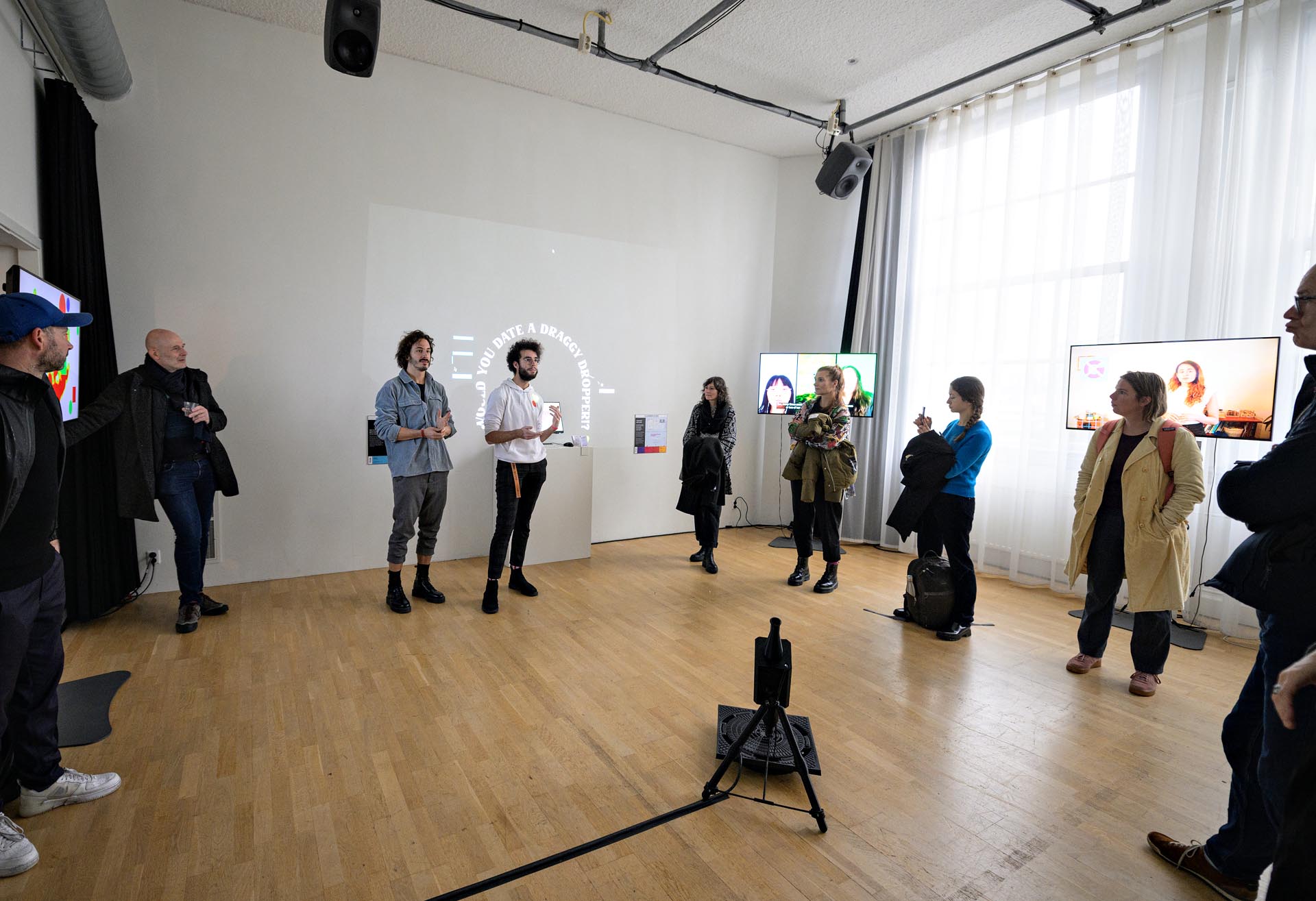
Overview of 'Reclaiming Digital Agency'. Photo: Pieter Kers
However, there are works in the space that lag Clickedy Click. Lag, because unlike Clickedy Click they are no longer in motion. Pay With Your Gaze by Ana Spagnolo López (AR), Helena Roig (ES), Marion Lissarrague (FR) and Vinciane Dahéron (FR), for example, which presents a frenetic, neon, abstract video world. In its original form, viewers were exposed to these visuals in a ‘lab setting’ and had their eye-movements tracked. On the very banal, relatable materiality of receipt-paper, the pattern of the eye movement created is printed, you have ‘payed’ with your attention and created your own little art-work edition of sorts. Though here, we are left with an aftermath of what could have imparted a tangible sense of commodification or ‘if the product is free, you are the product’. In being past-tense the content becomes fictive and distant and little urgency is transmitted. Altogether, the exhibition seems to angle for a ‘knowledge is power approach’, rather than a handbook of resistance – something I hope to discover later in the day. Since here, I don’t precisely feel I have the tools to reclaim my digital agency, rather, my lack of it has been made abundantly clear.
The exhibition seems to angle for a ‘knowledge is power approach’, rather than a handbook of resistance
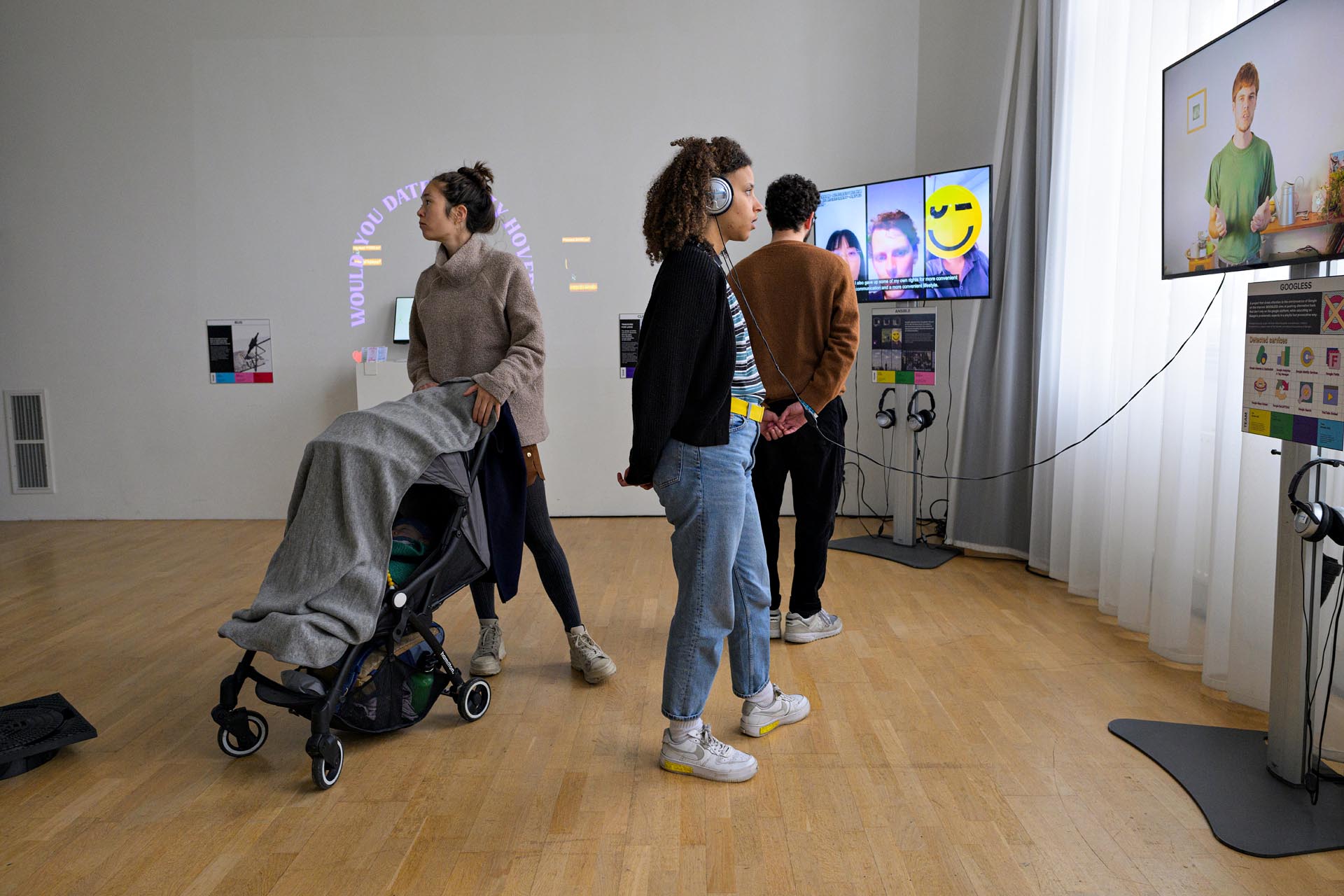
Before I took the 30 minute urban stroll to IMPAKT’s HQ, it was time for today’s panel discussion ‘Our Future With AI’. Maybe one of these experts might have some advice.
Second stop: panel discussion Our Future With AI, featuring Hind Dekker-Abdulaziz (NL), Vladan Joler (SR), Sebastian Schmieg (DE) and Ahnjili Zhuparris (US/CN)
After showing us a deep fake of Mark Zuckerberg looking no less human than usual as he speaks to us the transformative potential of AI across industries, the moderator quickly turns to artist Sebastien Schmieg. He introduces us to his work with generative image software. Like fishing trawlers, these softwares scrape the internet for all its content, irrespective of creative copyright – subsuming it into its data banks to later produce new images by amalgamating that which they have already consumed. Schmieg proposes that we think of these softwares as entities to persuade rather than tools to command; we should explore all possible outcomes as if playing a video-game – discovering new artefacts, creatures and worlds to uncover as we toy with their responses to our queries.
Following Schmieg, Vladan Joler relays to his perspective on ‘new extractivism’ wherein today, the user is ‘both the source-material and the end-product’. There is an important revelation in two of his points. Firstly, that ‘there is not much artificiality in AI’, generative image software uses ‘data-sets’ and in order for them to become viable systems for producing new images, humans create the taxonomies of language needed for the program to ‘understand’ the content of each image. Yet, using books as an analogue for images, he explains a quandary: ‘even all the books in the world will be a reflection of human bias … a data set of all of human creative history would be a reflection of [for instance] colonial powers’. The quandary here, is how and can we eliminate human bias? In his eyes it seems ‘a losing battle’, the larger these data sets become (and they grow exponentially), the harder the data sets are to unpack and interrogate. Though, soothing the desperation this reality induces, Hind Dekker-Abdulaziz, a member of the Dutch digital affairs committee, a working group of parliamentarians that focus on everything related to the digital.
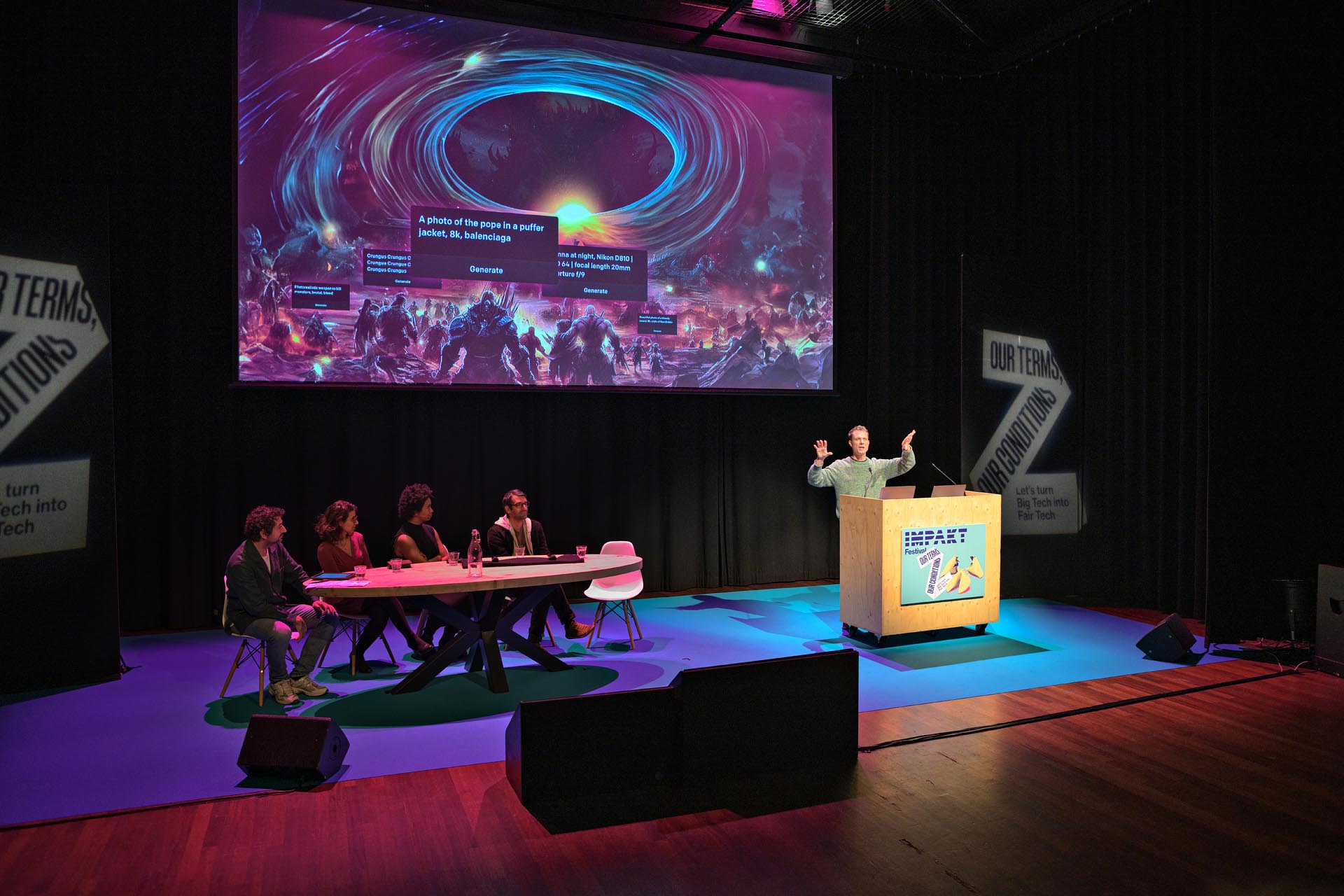
Sebastian Schmieg during 'Our Future With AI'. Photo: Pieter Kers
Lastly, Ahnjili Zhuparris, artist and Phd student introduces us to their research surrounding ‘wearables-based biomarkers’, (data-indicators of bodily/mental function gathered from wearable tech like smartwatches). This is a fascinating, yet worrying run-through of how seemingly tangental data can provide accurate predictions of health. An example Zhuparris gives, is how the fingerprint gestures on our screens might indicate an oncoming manic episode in a bipolar patient. Zhuparris provides us with some dark potential uses of this data: manic episodes can manifest as reckless spending, a search browser – without proper legislation to make the practice illegal – could extract this data, using it to increase prices of goods and services, exacerbating economic inequality.
Our future with AI is open, these panellists argue. It is here whether we like it or not and we need a robust ethical and legal framework to keep it on rails of our choosing

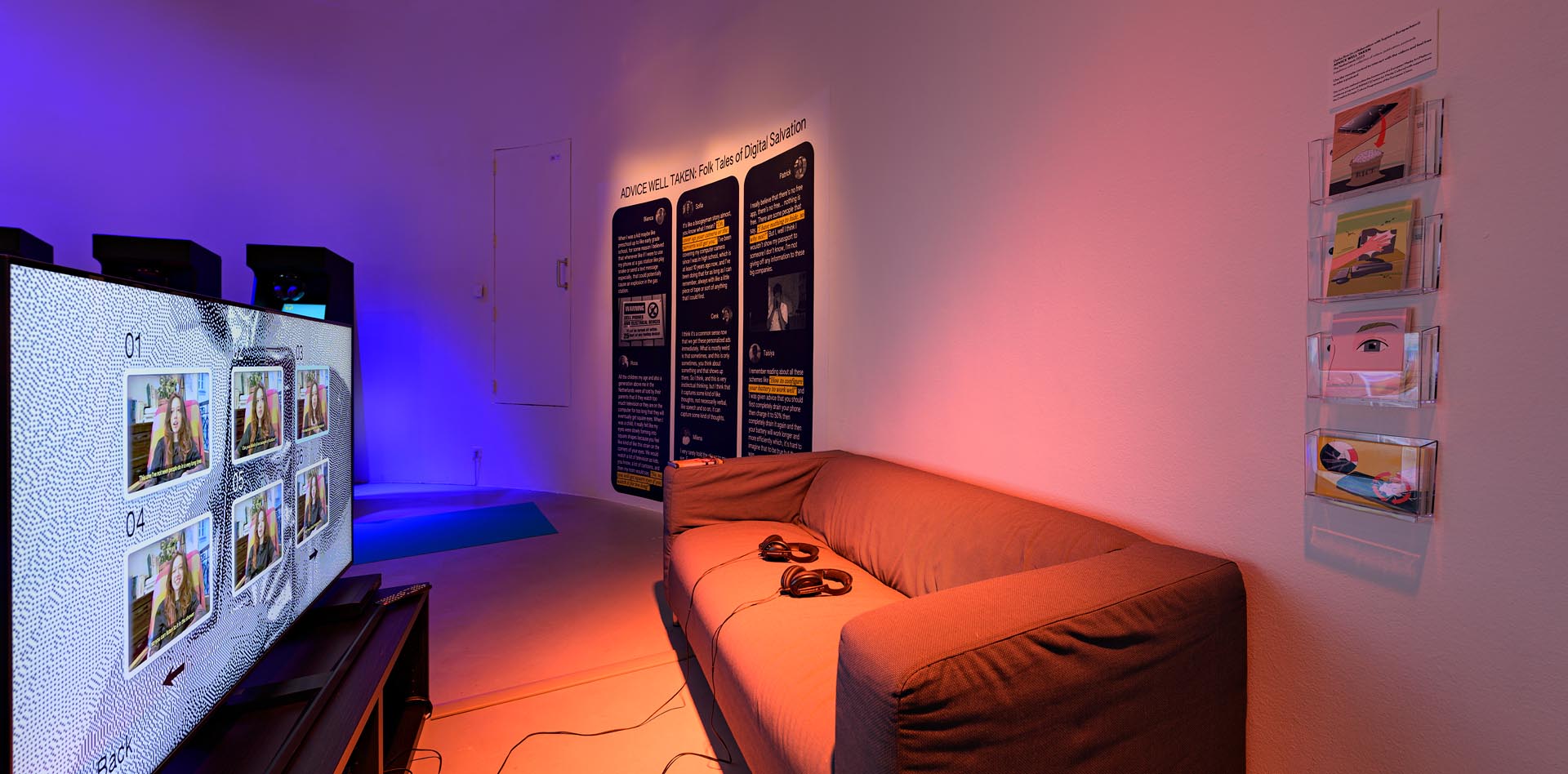
Ahnjili Zhuparris during 'Our Future With AI'. Photo: Pieter Kers
Our future with AI is open, these panellists argue. It could be a tool for great leaps in medicine, but it is inappropriate for say, child-benefit allocation. Knowing where it is useful and where it is harmful is key. It is here whether we like it or not and we need a robust ethical and legal framework to keep it on rails of our choosing. I’m not optimistic about ‘our future with AI’, maybe I’m cynical, but big-oil knew about the climate crisis since the 1960’s and today there’s still so little done in the way of decisive action. Whilst fascinating, and oftentimes charming, these 2 artists, a legislator and a PhD student, didn’t particularly assuage my anxiety. With only a couple of hours left of the day, this anxiety fuels a furious march through the spitting rain over to IMPAKT’s main building.
Third stop: DON’T BE EVIL @ Impakt
After the long trip, I am immediately drawn to the far end of the space – where I took rest in a cosy couch lit with warm yellow light, part of the installation titled Advice Well Taken (2023) by Dasha Ilina. In Advice Well Taken, Ilina ‘documents what she calls tech lore – ‘folk knowledge’ on the complex functionalities of the modern technology that surrounds us.’ This tech lore is presented through a series of first hand accounts and anecdotal storytelling. The accounts are presented in video interviews and a few instances of text on the wall. The installation is nostalgic for a millennial like me, as the works are presented through a DVD player: we pick up the remote, select a chapter on the screen and press play. It’s been years since I have done such a thing, so, in this cosy space, television in front of me, I feel like I am visiting a bygone era – a refuge from dystopia. Meanwhile, the tales spoken are remarkably mundane and grippingly human. In one scene, a man speaks to the struggles of using the Apple product ecosystem: things work, then they don’t; they need to be updated, get slower and break; bluetooth and streaming connections are interrupted by poor connection – every upgrade requires another upgrade. This frustration leads the interview candidate towards conspiratorial thoughts (and they’re half true): is this all this intentional? Yes, Apple is known to leave inbuilt obsolescences in their products, artificially fuelling the need for new devices.
Mind-reading technology is a very real possibility
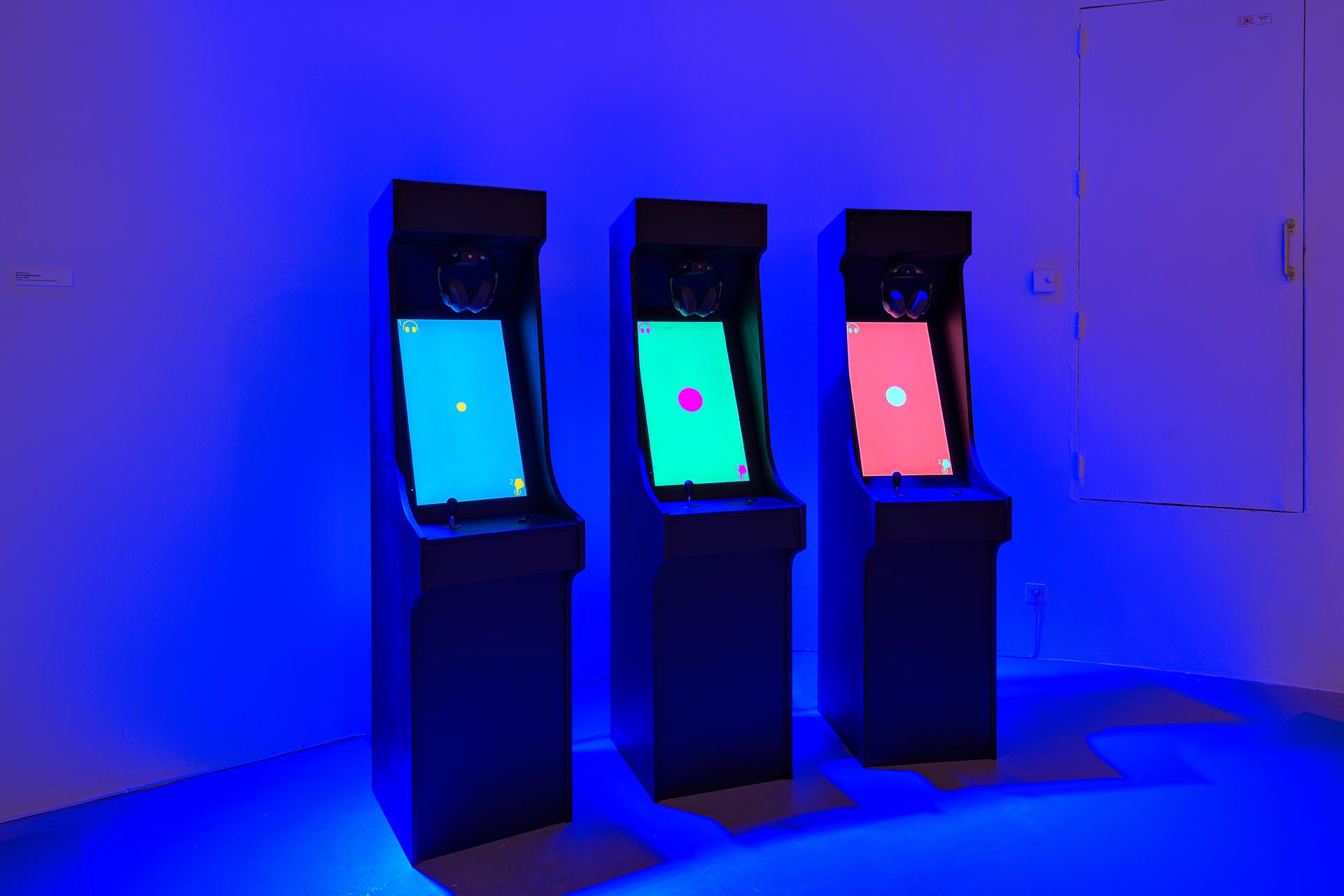
Roel Heremans, 'The NeuroRight Arcades' (2022), on view at 'Don't Be Evil'. Photo: Pieter Kers
This is but one of many stories that together, becomes an incredibly layered, qualitative and relatable study of people, wrangling with ‘innovation’ as it hits. Alongside it and in stark contrast, stands the far more ominous NeuroRight Arcades.
The NeuroRight Arcades (2022) by Roel Heremans are a sophisticated play of modern technologies behind the veneer of their vintage arcade-game shell. To engage with them, we jostle with the joy-stick and classic 2-button system as we’re guided through steps by a robotic, yet calm and paternal voice over. Next to Advice Well Taken, we can see two very different artistic approaches. Advice Well Taken, seems to appropriate oral history and human experience to note the outcomes or cultural symptoms of new technologies, whereas, Roel Heremans appropriates the new technologies themselves to create outcomes. In The NeuroRight Arcade, we wear a set of headphones with sensors that measure our brainwaves. Then, we’re asked to imagine our deepest secret and our most recent lie. The device measures our brainwaves, creating a wave pattern that could give our secrets away. This isn’t so far from reality, as through recent developments in AI we’re getting closer to being able to translate thought images to digital images. Mind-reading technology is a very real possibility.
The exhibition features many of these foreboding works that either underline present issues, or communicate oncoming challenges. Within, we witness how gentrification is accelerated by machine-learning, how our very own faces might stolen as unprotected commodities. Where these might leave you clenching your jaw, there is at least one moment of levity in Reinforced Learning (2023) by Jeroen van Loon. The work is a video series featuring a CGI crash-test dummy superimposed upon the bodies of people engaged in accidents, dances or what you call in online vernacular ‘fail videos’. There’s something in witnessing this representation of machine, undergoing our collective embarrassment that provides a little relief and a lot of schadenfreude – a kind of pleasure in seeing a symbol of something so threatening, be so ridiculed.
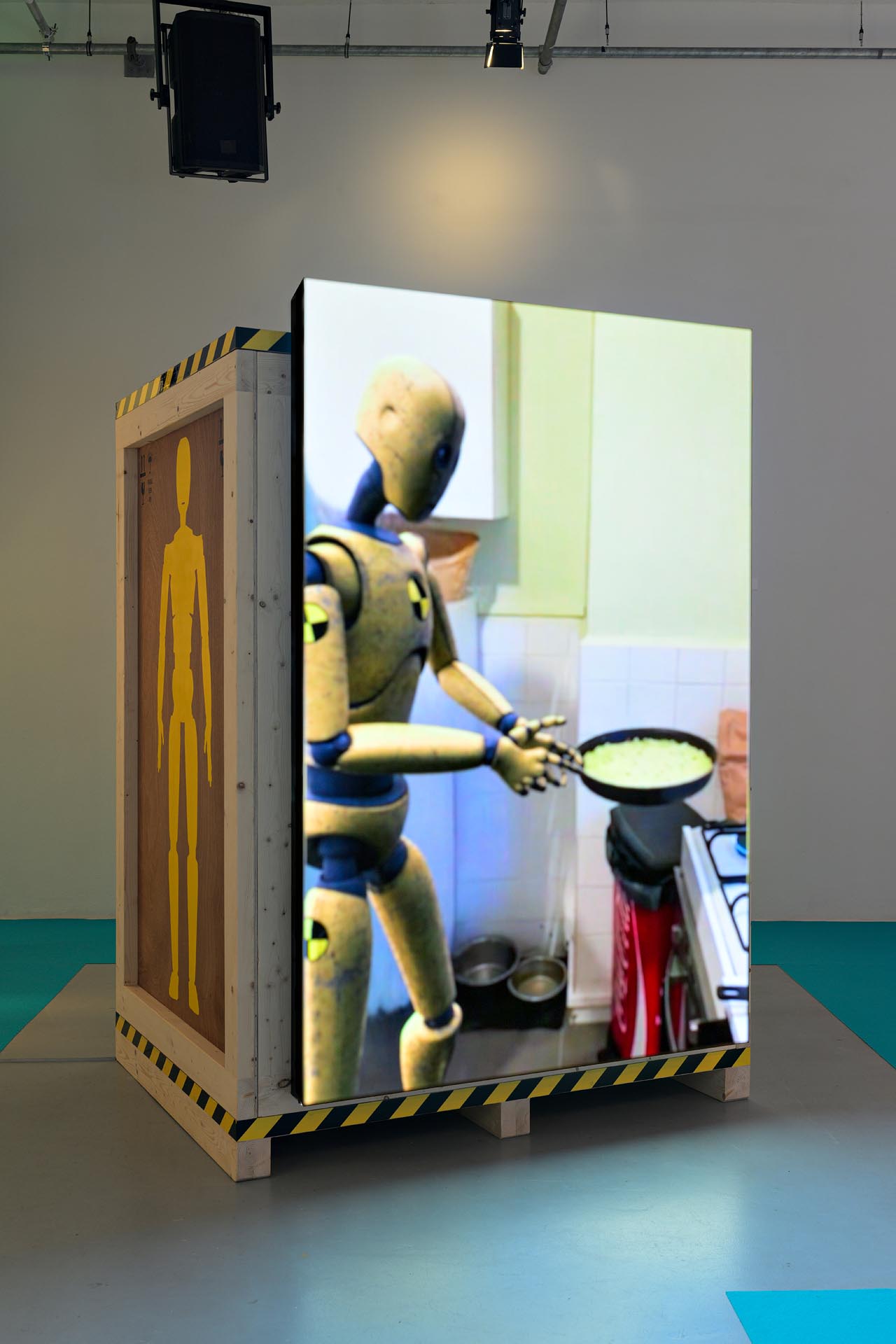
Does this festival leave me optimistic that ‘big tech’ might evolve into ‘fair tech’? Tentatively: in seeing so many talented creatives so fluently engage with their mediums, I was granted a sense that the tools that we fear are indeed our tools. We make them, can break them – can bend them to our ethics. Though, I’m left with the question of whether this is exceptional (to this space and these artists) or whether the industry can be legislated into accepting Our Terms, Our Conditions at large? The tsunami of AI and it’s subsequent drip into the ground-water of our collective experience is inevitable. Throughout the exhibits and talks, the current hegemony of companies; their often illicit and always consequential decisions were certainly made known. However, aside from allusions to new legislation by the government representative, in terms of action there was little in the way of defensive steps – of returning agency now. We’re certainly energised and greatly informed but, what to do? In being an incredible overview of local, foreign and international struggles, present and emerging: surveillance, systems of control, economic disparity, job precarity to name a few, I have high hopes that it instilled a taught sense of urgency in all those who visited, but I would have enjoyed at the very least a good VPN recommendation.
Don’t Be Evil and Reclaiming Digital Agency are on view until 7 January 2024 in IMPAKT [Centre for Media Culture]. Click here for more information
Matthew Sturt-Scobie


















